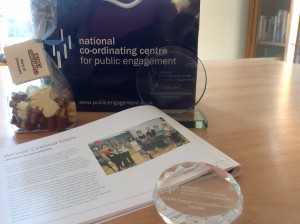Creative women and public engagement
We are very proud of our colleague Dr Laurie Stras, who has just won a major national award for bringing her research on early modern women musicians to a broad public. Here she tells us about how the award led her to a soapbox (strategically placed under a dinosaur) to debate questions around female creativity:

It was a wonderful thing, to be in the Natural History Museum yesterday – Universities Week had been in full swing for three days, and the place was buzzing with activity – everything from a dressing-up box for exploring the history of emotions, an exhibit explaining the life cycle of the fruit smoothie (complete with delicious samples), to futuristic electric cars that will revolutionize the National Grid.
I was there for two reasons. The first was to collect the award for winning the Individually-led Project category in the Engage Competition 2014, run by the National Coordinating Centre for Public Engagement. The award recognized my wonderful living lab – my amateur choir Celestial Sirens – and all the work they do to help me investigate music and performance practice in sixteenth-century convents. I was joined at the ceremony by novelist Sarah Dunant, with whom we worked for three years on the Sacred Hearts, Secret Music project.
![IMG_20140611_153423[1]](http://blog.soton.ac.uk/music/files/2014/06/IMG_20140611_1534231-300x225.jpg)
Several people asked what I thought about Beyoncé, Adele, and Madonna – how strongly can a woman express her commitment to feminism before she has to offset it with a show of flesh to keep the industry happy? One or two raised the recent debate regarding female conductors, agreeing that the idea that female conductors would be too sexually distracting for male musicians is an insult to both conductors and musicians. One thought that Kylie Minogue’s career was never better than after her fight with breast cancer, as it brought her audience closer to her. One challenged me to a game of “name the female producer.” It was a pretty short game.

One woman asked me what I thought the future held for women in music. I told her that the popular musicians I most admire are those that bypass the issue of sexualisation – artists like Janelle Monáe and Imogen Heap, who are far more interested in the interface between the body and technology, and who produce music that challenges our preconceptions about women in pop. Monáe sings through a cyborg alter-ego; Heap makes music in three dimensions by “dancing” her hands in technologically-enabled gloves.
But the best part of the whole day was being a musicologist in the midst of so many other researchers, most of them scientists, and feeling like I was there on my own terms – convincing the public that musicology really is a Thing, that it matters, and that there many conversations to be had. That, and getting to hang with the dinosaurs…

